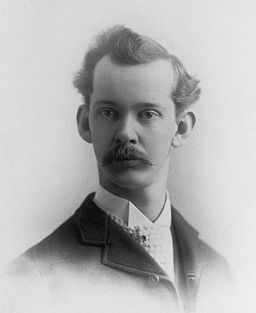Wilbur Scoville’s heat scale
It’s impossible to read much about hot peppers without bumping into Wilbur Scoville’s scale. In this post, I’ll explain Scoville Heat Units (SHU’s) and why you should care (but not too much).
 Wilbur Lincoln Scoville – 1865 – 1942
Wilbur Lincoln Scoville – 1865 – 1942
Back in 1912, American pharmacist Wilbur Scoville came up with a way to measure and compare the burning sensation one gets from eating hot chilies. He enlisted tasting panels of 5 people to try samples of pepper essence diluted in water. The number assigned indicates how much water is needed to eliminate the heat (the ratio of water to pepper).
 10,000 Scovilles is very hot for jalapeños. The little red square represents the quantity of jalapeño pepper while the blue shows the relative volume of water you need to add if you want to avoid any heat. That’s just a “medium” burn compared to peppers like habanero, scotch bonnet or ghost.
10,000 Scovilles is very hot for jalapeños. The little red square represents the quantity of jalapeño pepper while the blue shows the relative volume of water you need to add if you want to avoid any heat. That’s just a “medium” burn compared to peppers like habanero, scotch bonnet or ghost.
To illustrate, Tobasco tops out around 5,000 Scoville heat units. By coincidence, there are about 5,000 drops of water in a cup. So that means it takes 1 cup of water to overcome the heat from 1 drop of Tabasco sauce.
A score of zero means no heat (think sweet bell peppers) while today’s hottest chilies score upwards of 2,000,000! That translates to 1 drop in 100 litres of water. For metric resistors, that’s 1 drop in 26 US gallons!
The SHU score is not very precise due to the differing taste buds of the testers plus the fact that the heat varies widely even between two peppers of the same species grown on the same plant. Different parts of the same pepper also deliver wildly different heat! That’s why you normally see peppers rated using a very wide range. Jalapeños can run anywhere from 2,500 to 10,000 SHU’s.
Here are a few SHU reference points for the hot chilies you’ll commonly find in grocery stores:
- Habanero 200,000 – 350,000
- Cayenne 30,000 – 50,000
- Jalapeño 3,500 – 10,000
- Poblano 1,000 – 2,000
What Wilbur Scoville was actually measuring is the concentration of the compound, capsaicin. Capsaicin (pronounced cap-SAY-sin) is the natural chemical that gives chilies their fire. More about capsaicin in an upcoming post.
While I like a nice hot pepper spice (even when I break into a sweat), hitting the highest SHU score is not my goal. In my view, ghost peppers and the rest of those ‘super hots’ are way too fiery to enjoy since the burn overpowers the taste. Instead, I aim for a balance to allow the wonderful flavours to shine alongside the right amount of heat.
Sources and further reading
Wikipedia.org, Scoville scale
Smithsonian Magazine, How Hot is That Pepper? How Scientists Measure Spiciness, January 2013
chiliworld.com, The Scoville Heat Scale
Related Posts
- What is Chipotle?
Chipotle is a traditional Mexican method to preserve jalapeño peppers using slow-smoking and drying.
- Mexican Chilies (or chiles or chillies)
Chilies are a cornerstone ingredient in Mexican cuisine. There’s a vast array of different Mexican…
